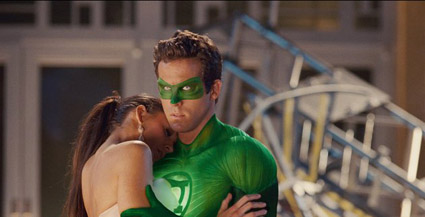Things I Learned From Movie X: Green Lantern
By Edwin Davies
January 26, 2012
This leads me to believe that the Lanterns' methodology for choosing members - that they should be pure of heart, brave and all that bullshit - is fatally flawed. Sure, Hal Jordan's a good person who wants to help people, but he's also a fighter pilot who displays next to no ability to think laterally in tough situations. He uses the most obvious things he can think of to solve the problem, which not only reflects poorly on his imagination, but also squanders the considerable budget of the special effects blockbuster built around him. Personally, I think they should re-evaluate their selection process so that, rather than choosing people who are decent and will likely save peoples' lives, they should go for people with really fucked up imaginations. Imagine if, instead of Hal Jordan, they had recruited H.R. Giger. No one is going to mess with Earth when its protector can conjure phallus shaped machines with the faces of screaming babies at will.
A hero is only as good as his villain
There are two main villains in Green Lantern: a giant yellow cloud named Parallax, which is voiced by Clancy Brown and is, therefore, awesome, and Hector Hammond, played by Peter Sarsgaard, who is pretty good too, in his own non-Clancy Brown way. Parallax spends much of the film floating in space and generally scaring everyone else into action, whilst Hammond's journey from mild-mannered scientist to telekinetic freak is the main focus the rest of the time. There are a lot of interesting things about Hammond that could make him a good villain. He's an initially good man whose worst impulses are corrupted by Fear, as represented by Parallax; he has a bitter and resentful relationship with his father (played by Tim Robbins. That's right. Tim. Robbins.); and Sarsgaard does try to make Hammond's struggle with his baser instincts feel like a real battle. These are all things that could, theoretically, make for a great villain, especially with an actor like Sarsgaard who is a) very good in most things, and b) clearly having a whale of a time playing such an outsized character. There is a lot of solid material in place.
Unfortunately, with his red moustache, thinning hair and massive mangled forehead, Hammond looks less like a comic book villain, but rather like the Elephant Man as played by Ron Jeremy. Whilst that image is terrifying in its own right, it seems really out of place in a spectacle-driven superhero film.
No one can say the film-makers lacked optimism
It's become such a common practice for films to include an after-credits scene teasing the next film in the series that the inclusion of one such scene in Green Lantern shouldn't be particularly noteworthy: it's just following the pack. However, what sets this particularly scene apart is how completely unwarranted it is.
The scene itself involves Sinestro (Mark Strong) putting on a special yellow ring that is meant to harness the power of Fear, in the process corrupting him and assumingly setting him up as the villain of Green Lantern 2. That'd be a perfectly cromulent direction for the film to take if it had at any point in the intervening two hours portrayed Sinestro as anything other than a pure-hearted and dedicated servant who just wants to save the universe. There's no hint of danger or malice in him, nothing to suggest that he might break with the orders of his superiors to put on the ring, nothing, essentially, to suggest that he might have some villainy in him, let alone *super*villainy. Now, had they decided to show the struggle that this good man faces as he is overcome by the power of Fear over even a few minutes, rather than showing it happen in all of five seconds, then maybe the scene would have had some power. As it is, it takes one of the few likable characters in the film, turns him evil for no reason, then presumes that a sequel is in the offing, tainting any good feelings the audience might have about the otherwise upbeat ending of the film.
For the purposes of comparison, imagine if the first Harry Potter film had ended with Hagrid finding Voldemort and getting possessed by him. Wouldn't it have been an awful, unnecessary direction for the story to go? This is exactly the same thing, except Harry Potter was all charming and British, whilst Green Lantern is garish and dull.
Continued:
1
2




